We don’t think we’ve ever come across anyone who genuinely loved every aspect of their job. We all have some tasks to do as part of our responsibility that we would prefer to drop if we could. It may be all the emails, or some of those meetings or certain phone calls, but there’s going to be something that makes your heart sink when you think about it.
The effect of these tasks spreads beyond the task itself. When you know you have to do it, it can negatively colour your whole day:
• It brings out the most developed avoidance procedures we have
• We generally don’t do the task itself as well as we might
• It uses up a lot of our energy that could be better expended on things we get satisfaction from
This is too high a price to pay, so it’s worth re-examining our attitude towards these tasks.
What can you do about it?
1. Divide the task into smaller chunks
These tasks can easily become ‘elephants’ in our minds, so break it down into smaller parts: plan to make 1 phone call, not 5; clear 5 extra emails, not 10; avoid back-to-back meetings (at the very least make sure you’ve got 10m minutes between each one); give yourself a little space to breathe – diary in some reflection time; plan a little time each morning to plan your priorities and a little time to get back your perspective at least once a week.
2. Experiment with when in the day you do the tasks you don’t enjoy
We are all better at doing the less attractive tasks at certain points in the day. For example, you may find that first thing in the morning you can tackle something you don’t like, and then feel virtuous for the rest of the day. Or it might be that the end of the day, you’re only fit for something tedious!
3. Do something different
Look for ways to make it more enjoyable or at least interesting. What motivates you? It may be listening to some music, if appropriate, while doing it, or having a little competition with yourself – how many can you do in the next half hour? Or it may be giving yourself the added task of finding something to take away from that meeting, or something delightful about that person you don’t normally connect very well with.
4. It’s OK to avoid things sometimes
There’s nothing wrong with avoiding things if a) it’s not something that makes your priority list that day b) that actually it’s something that you don’t have to do or you’re not the best person to do it i.e.: it’s not really something that you need to do at your level. Ironically sometimes something you don’t like is something that other colleagues are happy to do – so can you delegate it to someone? Or swap it for one of their tasks that you wouldn’t mind doing?
It’s daft to continue to let a part of your job, and often a small part, bring down your mood for other things you have to do. When we let the small things disproportionately affect us, it can ruin our motivation for the entire day. Experiment with ways of making it work for you, and save your energy, creativity and drive for making a positive difference to the things that really matter.
We hope this blog has been useful to you, we think it’s about time that we began to really use the precious time that we have at work to do what needs to be done in a more effective way, working at a sustainable pace that ensures quality and creativity – we’re sharing this because we believe you can and DO make a difference to the organisations you work with, and if we can make your work day that bit easier, well, that’s what we’re in business for!
Have a great month,
In peace,
Di and Jo xxx



